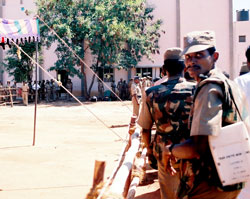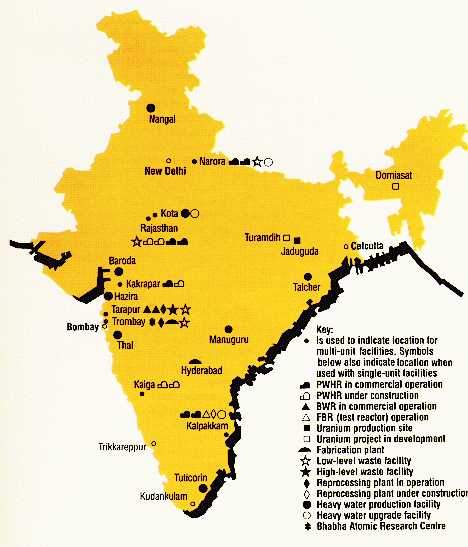Ilankai Tamil Sangam30th Year on the Web Association of Tamils of Sri Lanka in the USA |
||||
 Home Home Archives Archives |
Koodankulam Goes Nuclearby Manju Menon and M V Ramana, Himal, August, 2007
In June, a public hearing proved that construction on India’s largest nuclear-energy project faces similarly massive opposition – but officials seem undaunted. On the southern tip of India, barely 20 km from Kanyakumari and just across the water from Sri Lanka, the public-sector Nuclear Power Corporation of India Limited (NPCIL) is setting up two 1000-megawatt nuclear reactors – the largest such plants in the country. Though construction on both of the Russian-built reactors is currently behind schedule, NPCIL has already proposed to import four additional nuclear generators, for installation at the same site.
To fulfil a mandatory step in the official environmental clearance process, on 2 June the Tamil Nadu State Pollution Control Board conducted a public hearing. From the outset, the distinct impression at the meeting was that the state administration was hoping merely to be done with an undesirable formality. What is more, they allowed NPCIL to use the hearing as a platform from which to promote the project and to make unsubstantiated claims about the reactors’ safety. But things did not go according to the official script. Locals of the area had been fed pro-nuclear rhetoric for years, and nearly 7000 people gathered to take advantage of the first official opportunity to put their own views on nuclear-energy production into the public record. Almost to an individual, they said that they were opposed to the project. As participant after participant spoke against the Koodankulam plan, the official in charge abruptly announced that NPCIL had clarified all the people’s doubts, and declared the meeting closed. Contrary to the requirements of the law, the minutes of the meeting – what would enter the official record as the public’s views – were not read out. The current work at Koodankulam is the culmination of a deal signed back in 1988 between India and the then-Soviet Union. According to the agreement, the Soviet Union was to provide concessional state-to-state credit for the reactor, priced then at INR 47 billion. This was barely two years after the Chernobyl disaster, and the Soviet nuclear industry was desperate to improve its image. For its part, over the preceding decades, India’s Department of Atomic Energy (DAE) had failed to deliver on its claims to power generation. In the early 1960s, DAE officials had predicted around 25,000 MW of installed capacity by 1987; in fact, by the mid-1980s it had only managed 1000 MW: the Koodankulam reactors would have more than doubled that figure. The deal, then, was to have been a fillip to both the Soviet and Indian nuclear industries. Unfortunately for both, with the collapse of the Soviet Union, project plans were shelved.
The project lay dormant for a time due to uncertainties in Russia; but with the improvement of the Russian economy, it was revived in June 1998. By then, the project’s cost had risen to over INR 130 billion, for which Moscow again agreed to extend state credit. Once more, a significant factor in the resuscitation of the Koodankulam plan was the sorry state of the Russian nuclear establishment, which was suffering from the migration of skilled personnel to the West, as well as a dwindling number of orders. For its part, the DAE was keen on finding a country to break ranks and flout the international understanding that nuclear commerce was not to be conducted with India, given New Delhi’s multiple nuclear-weapons tests conducted that very year. An educated public In November 2001, S P Udayakumar, a peace-studies scholar and activist based in nearby Nagercoil, along with a group of friends, founded an umbrella organisation called the People’s Movement against Nuclear Energy. Since that time, the organisation’s activists have spoken with tens of thousands of concerned citizens in the area, from all walks of life. The results of these activities were clearly visible at the public hearing in early June: the participants were very well informed about the social and environmental impact of the Koodankulam reactors. The opposition that had grown over the past decade triggered intimidation tactics by the administration. In the run-up to the public hearing, activists were subjected to frequent phone calls from the police; this past April, several activists from Koodankulam village were taken into police custody on false charges. At the 2 June public hearing, about 1200 policemen were deployed – clothed in riot gear and armed with water cannons (see pic). Buoyed in part by the public-education work of groups such as the People’s Movement against Nuclear Energy, opposition to the Koodankulam project has been primarily driven by local concerns, particularly the threats posed to fishing and to water for both drinking and agricultural use. A more recent concern, following plans to expand the project, has also been the displacement of people inhabiting nearby villages and settlements. Due to the risks associated with nuclear technology, international standards require reactors to be located far from population centres. But in this situation, three large villages are within just five kilometres of the reactors: Koodankulam (population 20,000), Idinthakarai (12,000), and a new tsunami-rehabilitation colony with more than 2000 residents. But communities farther away from the site would also face considerable threat should an accident occur. A good measure of radiation risk is the concentration of the radioactive element known as Cesium-137. Following the Chernobyl accident, for instance, dangerous levels of Cesium-137 forced the imposition of strict radiation-control measures over about 10,000 square kilometres near the site. In the event of a catastrophic accident at Koodankulam, depending on the prevailing atmospheric conditions, such concentrations of Cesium-137 could occur up to 400 km away. Should the wind be blowing eastward, this could cover a large swath of western Sri Lanka, including Colombo. Even without accidents, the reactors would inevitably affect the area’s environment. They would, for one, routinely emit radioactive discharges. In addition, every year, the six 1000-MW reactors would together spew out over 10 billion cubic metres of hot water into the Bay of Bengal, several degrees Celsius above the sea’s prevailing temperature. Naturally, fisherfolk are concerned about their livelihoods, which are already under threat from various other encroachments. Of perhaps greater concern is that this hot water would be discharged into the Gulf of Mannar, a biosphere reserve considered one of the world’s richest marine areas, supporting at least 3600 species of flora and fauna, of which 377 are endemic. No regulation Perhaps one should consider it fortunate that the project managers were even forced to hear from the public at all. In 2005, the DAE had asked for some of its projects to be exempted from even this token public consultation. And if there were to be public hearings, DAE officials demanded that they be limited to project-affected people and what it considered ‘genuine professionals’. (Activists and NGO personnel were to be denied an opportunity for any input.) Shortly thereafter, in 2006, the EIA notification was indeed amended to limit participation in public hearings, and several researchers have subsequently been rejected from presenting their views at hearings. The Koodankulam project is symptomatic of the problems inherent to India’s decision-making processes on environmental issues. Through a series of amendments over the past two decades, the mandatory procedures laid down under the Environment (Protection) Act of 1986 have been rendered incapable of stopping the implementation of poorly planned and environmentally disastrous projects. Increasingly, the official aim appears to be to ensure that environmental clearances are readily given and projects speedily executed. Despite the outpouring of anger that took place at the NPCIL public hearing, as well as the environmental problems inherent in the project, the Koodankulam project might well be granted clearance. Local groups and concerned individuals, however, have continued to contest it. A legal notice was sent to the Tamil Nadu Pollution Control Board on 15 June, citing various violations of environmental norms and procedures, and asked for the board to reconvene public hearings. A case was also lodged in Madurai High Court in late June, asking for a special public hearing for the inhabitants of Koodankulam village. Not only do these citizens stand to be most affected by the project, but many had not been able to enter the hearing hall on 2 June due to lack of seating – several thousand had arrived, while the hall could accommodate only 800. Activists have now announced that they will begin a relay fast in protest in August. Koodankulam is by no means exceptional. Examples such as the large-scale hydroelectric projects in Kerala, Chhattisgarh and Arunachal Pradesh demonstrate that popular understanding of the negative repercussions of such mega-projects is growing, and resulting in stiff resistance. As the Indian stock market continues to rise, though, such proposals are multiplying. With the attendant conflicts becoming keener, the need to adopt an alternative way to meet energy needs without sacrificing local livelihoods or environmental sustainability has never been more urgent. |
|||
|
||||

